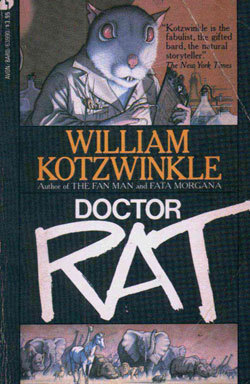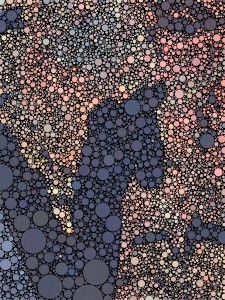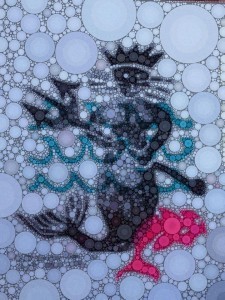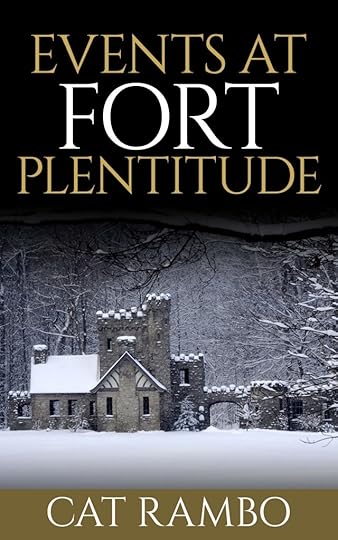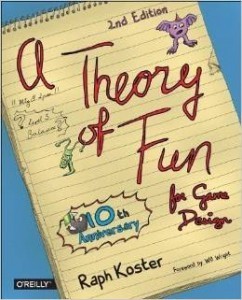Cat Rambo's Blog, page 55
December 8, 2014
Teaser: From “Red in Tooth and Cog”
This is what I’ve been working on today. It’s a lot closer to being done that it was.
This is how Renee lost her phone and gained an obsession.
She was in the park near work. It was a sunny day, on the edge of cold, the wind carrying autumn with it like an accessory it was trying on before settling for it for good.
She set her phone down on the bench beside her as she unfolded her bento box, levering back metal flaps to reveal still-steaming rice, a quivering piece of tofu.
Movement caught her eye. She pulled her feet away as a creature leaped up onto the bench slats beside her, an elastic band snap’s worth of fear as it grabbed the phone, half as large as the creature itself, and moved to the other end of the bench.
The bento box clattered as it hit the concrete, rice grains spilling across the grey.
She’d thought it an animal at first, but it was actually a small robot, a can-opener that had been greatly and somewhat inexpertly augmented, modified. It had two corkscrew claws, and grasshopper legs made from nutcrackers to augment the tiny wheels on its base that had once let it move to hand as needed in a kitchen. Frayed raffia wrapped its handles, scratchy strands feathering out to weathered fuzz. Its original plastic had been some sort of blue, faded now to match the concrete beneath her sensible shoes.
The bench jerked as the robot leaped again, moving behind the trash barrel, still carrying her phone. She stood, stepping over the spilled rice to try to get to the phone, but the leaves still on the rhododendrons thrashed and stilled, and her phone was gone.
You Should Read This: Doctor Rat by William Kotzwinkle
The newer books have a different cover, but this has always been my favorite version.
Doctor Rat is a cunningly well constructed, heartwrenching, horrible wonderful book told from the point of view of an insane rat, thereby reinforcing my theory that odd povs may add to, rather than detract from, good fiction. Be aware: this is a novel about animal experimentation and it pulls no punches.Doctor Rat witnesses the experiments being carried out on his fellow animals, wandering through a laboratory and speaking to us in a way that makes it clear whose side he’s on while showing how brutal the details of this book can be:
I should now like to sing “Three Blind Rats.” It’s part of the experimental program of music that’s being channeled toward certain rats, to make them more docile and sweet. Several of them are indeed beginning to nuzzle up to each other, one of them even executing a light-fantastic tripping of his tail, in time to the beat.
In the cage beside him, we actually have three blind rats. In fact, we have twenty-three blind rats, part of a magnificent new experiment initiated by a very ambitious student, who I’m featuring in this month’s Newsletter. He’s a sensitive chap and it was his exquisite sensitivity that caused him to dream up the item that’s become the latest rage here at the lab: the fabulous removal of eggs from a female rat’s body and the grafting of them to different parts of the male rat’s body — to the tail, to the ear, to the stomach. And for the past twenty-three days he’s been grafting them to their eyeballs! So now it’s time we all sang that promising young scientist a song.
Doctor Rat is not all horrifying detail though. There’s a lot of sweetness to it, including a moment where a human orchestra plays music in order to warn whales of approaching whalers that makes me cry, every time, while read silently or aloud. The amount of emotion it manages to stir in me is visceral. I wish I knew how Kotzwinkle accomplished it.
Which brings me to another reason by I think this is a good book for writers to read: this is a book that manages to be harrowing and uplifting all at once. It’s the sort of book that a writer confronting a real evil produces, a look that is cynical and despairing and yet tinged with a dark humor that lets you know there may be a glint of light somewhere. This is the sort of book you should read through once in order to experience it for the first time; then go back and see how the writer accomplished that experience. Doctor Rat looks at difficult, political things in a way only the greats manage.
Kotzwinkle is still around and is a prolific of both adult and children’s books. The child in me is compelled to note that the latter includes the “Walter the Farting Dog” series.
#sfwapro
December 5, 2014
You Should Read This: The True Game Trilogy by Sherri S. Tepper
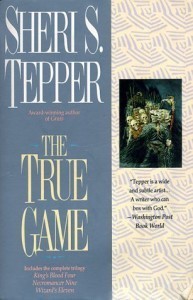 I first encountered this series in the late 70s, while a teen, and it hooked me to the point where I’ll always note a Sheri S. Tepper book coming out, even though some have gotten a little didactic. But this series? Not only is it is awesome, but it interlocks with two other trilogies set in the same world and with many of the same characters.
I first encountered this series in the late 70s, while a teen, and it hooked me to the point where I’ll always note a Sheri S. Tepper book coming out, even though some have gotten a little didactic. But this series? Not only is it is awesome, but it interlocks with two other trilogies set in the same world and with many of the same characters.
While The True Game Trilogy starts in what seems to be a fantasy world, where different people manifest different Talents that play off each other in a massive societal game. Protagonist Peter is part of a school that teaches its students how to play the game, and part of the joy of the book is the detail with which the game is worked out:
“Talisman,” I blurted. “Talisman to King’s Blood Four.”
“Good.” Gervaise actually smiled. “Now, tell me why?”
“Because our side can’t see what pieces may be hiding behind the King. Because Talisman is an absorptive piece, that is, it will soak up the King’s play. Totem is reflective. Totem would splash it around, we’d maybe lost some pieces…”
“Exactly. Now, students, visualize if you please. We have King, most durable of the adamants, whose ‘blood,’ that is, essence, is red light.Demons, most powerful of the ephemera, whose essence is shadow. Tragamors making barriers at the sides of the Demesne. The player is a student, without power, so he plays Talisman, an absorptive piece of the lesser ephemera. Talisman is lost in play, ‘sacrificed’ as we say. THe player gains nothing by this,but neither does he lose much, for with this play the Demesne is changed, and the game moves elsewhere in the purlieu.”
Peter thinks himself Talent-less but when it does emerge, it leads to danger connected to the secrets around Peter’s birth.
The magic system is lovely, there’s two strong female characters in the form of Jillian and Mavin Manyshaped,ach of whom gets her own later trilogy (with its own version of earlier events), the characters are engaging and/or often disturbing, and the plot is nicely put together, slowly shifting over to reveal itself to actually be science fiction.
There are others of Tepper’s works that I’d recommend — I adore the Marianne series, for one, and I reread Grass on a regular basis, as well as The Gate to Women’s Country. But this series was my gateway to Tepper and as such it has a pull for me above all the rest. If you want to know more about Tepper hereself, here’s an interview she did with Neal Szpatura for Strange Horizons in 2008 and an interview with John Scalzi.
#sfwapro
December 4, 2014
You Should Read This: Poetry As Insurgent Art by Lawrence Ferlinghetti
You must decide if bird cries are cries of ecstasy or cries of despair, by which you will know if you are a tragic or a lyric poet. -Lawrence Ferlinghetti
One of the distinctions that I sometimes hear people making is “regular” Sf and “literary” SF, usually with some baggage about the literary SF being art. I say, if you’re making something you don’t really interact with for food, shelter, or clothing (and even then, in some cases), you are probably making art.Word-wrangling is art, no matter whether it is used for the lowest purposes or the most exalted, and the artist who relaxes and enjoys it learns to use artful techniques for the entertainment or edification of her/his readers. And they may, in that process, create something lasting.
At the same time, a dose of art in whatever form — visual, music, verbal — can shake things loose in our heads to the point where better and more interesting words fall out. This is why you should read books like Poetry as Insurgent Art.
Here’s Ferlinghetti himself on the notion of rejecting poetry, aka all that artsy stuff.
Don’t let them tell you poetry is bullshit.
Don’t let them tell you poetry is for the birds.
Have a good laugh at those who tell you poets are misfits or potential terrorists and a danger to the state.
Don’t let them tell you poetry is a neurosis that some people never outgrow.
Laugh at those who tell you poetry is all written by the Holy Ghost and you’re just a ghost-writer.
Don’t ever believe poetry is irrelevant in dark times.
If you’ve ever been inside Ciy Lights Bookstore in San Francisco, you’ve walked the same floorboards as Ferlinghetti, who co-founded the store with Peter Martin in 1953. He and Shig Murao, the manager, were arrested in 1956 on obscenity charges for selling copies of Allan Ginsberg’s Howl.
Why should you read this? I tell you what. I’ll let Ferlinghetti speak for himself by quoting the beginning of Poetry as Insurgent Art.
I am signaling you through the flames.
The North Pole is not where it used to be.
Manifest Destiny is no longer manifest.
Civilization self-destructs.
Nemesis is knocking at the door.
What are poets for, in such an age? What is the use of poetry?
The state of the world calls out for poetry to save it. (A voice in the wilderness!)
If you would be a poet, create works capable of answering the challenge of apocalyptic times, even if this means sounding apocalyptic.
You are Whitman, you are Poe, you are Mark Twain, you are Emily Dickinson and Edna St. Vincent Millay, you are Neruda and Mayakovsky and Pasolini, you are an American or a non-American, you can conquer the conquerers with words.
If you would be a poet, write living newspapers. Be a reporter from outer space, filing dispatches to some supreme managing editor who believes in full disclosure and has a low tolerance for bullshit.
Ferlinghetti should be read as a subversive act:
The idea of poetry as an arm of class war disturbs the sleep of those who do not wish to be disturbed in the pursuit of happiness.
The poet by definition is the bearer of Eros and love and freedom and thus the natural-born non-violent enemy of any police state.
Read this for the sake of poetry, “the last lighthouse in rising seas.”
December 3, 2014
Writing-Related Link Roundup from November 2014
If you're looking for an interesting online writing class to keep productive during December, I've got both a flash fiction and a "Moving Your Story from Idea to Draft" workshop coming up on the 20th and 21st.
Maybe not as timely as it could be, since everyone’s finishing up Nano novels, but just in case: 8 Ways to Outline a Novel on LitreactorSome of you have two weeks left to sub to She Walks in Shadows. All woman Lovecraft antho, pays 6 cents a word (pro rate). Guidelines.
Good piece about science-fiction writer Nnedi Okarafor on BookRiot. “I came to her work at a time when the debate about a woman’s place in the world of science fiction, fantasy, and speculative fiction was getting a lot of buzz. I realized that I’d read a few of the women who’d made their mark in that realm – Ursula K. LeGuin, Octavia Butler, Margaret Atwood, Jo Walton- but I felt as though I hadn’t gone far enough. Okorafor’s stories have encouraged me to travel further down that path.”
Interested in a writer’s retreat? Here’s a pretty good list of them.
Ray Bradbury talks about creativity and how our motives shape our writing. On the same site, Umberto Eco talks about the pleasures of maps of imaginary places.
What happens in your head while you’re reading? Your brain on stories.
David Cronenburg is interviewed about his process of novel writing, as well as finding beauty in unlikely corners. “There are many realities we need to ignore in order to function. Whenever we’re reminded of that, however obliquely, it is very disturbing—there’s a real dissonance that’s happening there. But of course it’s part of the function of art to keep that dissonance happening.”
An article with a lot of resonance for the self-pub versus traditional publishing argument about day jobs, found via M.C.A. Hogarth.
In The Atlantic, Jeff VanderMeer talks about the uncanny power of weird fiction.
Great piece about writers and their real influences, the things that shape their writing.. “I have a theory: the thing that makes you a unique writer hasn’t got so much to do with your influences as it does with how you became a writer in the first place. I think your preferences—your obsessions—come just as much from the first sorts of things you consumed and were passionate about. Whether that’s pop music, comics, “lowbrow” fiction, soap operas, or anything else, the thing that matters most is what started you writing stories.”
You Should Read This: Shelter by Susan Palwick
For writers, it's worth reading the book a few times in order to see how the points of view, particularly that of the AI, are handled.
Shelter by Susan Palwick is one of the reasons why I will never question the use of anything, be it shoe, gun, elephant, or even a rope, as a protagonist. That is because one of the multiple viewpoints it’s told from is that of a house, or to be more precise, the AI running it, and it is done so in such a way that it is integral to the story as well as entrancing.Palwick is one of my favorite science fiction writers. She can wring your heart dry or make you laugh, and I always emerge from one of her stories still wrapped in it, thinking about it for hours, sometimes days afterwards, unfolding some of the thoughts arising in answer to the questions and observations she presents.
Jo Walton talks eloquently about Shelter in a column for Tor.com, which I read earlier this year in the collection What Makes This Book So Great (also highly recommended). Walton also calls out the point of view:
The book opens with the third narrator, House, an AI convinced it isn’t an AI. AIs are illegal in the US because they’re defined as legally persons, and therefore owning them is slavery. There’s also the AI terrorism problem… The House’s point of view is done beautifully. It feels entirely real, entirely immersive, and you can really believe the way it reasons its way through decisions. The book begins in the “present” of the story, during a very severe storm (global warming has got worse) and goes back to the earlier events that led to the world and the relationships we’re given at the beginning. Palwick directs our sympathies as a conductor directs a symphony. The twenty years of history and events we’re shown, from different points of view, build up a picture of a future that has clearly grown from our present. Every detail has second-order implications—you have bots doing the cleaning, so you have people afraid of bots, and people who think doing your own cleaning is a religious act, and you have sponge bots trying to stem a flood as a metaphor for people unable to cope.
In my Writing Fantasy & Science Fiction Stories class, we often look at the first paragraphs of works to see how much gets set up in it. Palwick’s constructs a world that clicks neatly in place as each sentence unfolds:
That same morning, Kevin Lindgren’s house warned him not to go outside. The house knew the sky was dangerous. Everyone knew. Kevin didn’t even need a house with a brain to tell him: all the newscasts said so, and special bulletins during the soap operas and talk shows, and, most especially, the sky itself, gray and howling, spitting sheets of rain and barrages of hailstones. Kevin himself knew that the sky was dangerous. Not fifteen minutes before he left the house, he’d watched a gust of wind pick up the patio table on his back deck and blow it down Filbert Street. Filbert wasn’t really a street at all, here; it was actually ten flights of steps leading steeply down Telegraph Hill to Levi Plaza and the waterfront. The patio table was teak, and quite heavy, but even so, the wind sent it a long way down the steps, until finally it came to rest in a neighbor’s garden. It could just as easily have gone through the neighbor’s roof or window.
Palwick is a writer I watch for. With her books it’s not so much a question of whether I’ll buy them as when. She’s also written one of my favorite replies to Daniel Keyes’ Flowers for Algernon in the title story from her collection The Fate of Mice. Anything by Palwick is good, but Shelter shows how marvelous SF can be in the hands of a master.
#sfwapro
December 2, 2014
Two Stories Free on the Kindle Through Friday (12/5/2014)
I didn’t track my scheduling closely enough and ended up with two KDP deals available this week, so if you would like two free stories, one from the Tales of Tabat series and the other from the Farther Than Tomorrow series, here you go!
An exiled soldier tries to wait out a winter in a fort beleaguered by fox-spirits and winter demons.
On a distant planet, David struggles to overcome his husband's betrayal, only to find an unlikely sympathizer in the form of one of the planet's native inhabitants. But are its intentions truly benign?
You Should Read This: The Blazing World by Margaret Cavendish
Margaret Cavendish, Duchess of Newcastle and author of The Blazing World
If you want to explore the deepest roots of fantasy and science fiction, here’s a text that’s been obscured by time: The Blazing World by Margaret Cavendish, which is one of the first portal stories, in which a protagonist ends up in a world much unlike their own, as well as a Utopian novel. Written in 1666, it features a heroine who enters another realm, the Blazing World of the title, through an entrance located at the North Pole. There, she ends up becoming empress of a harmonious and progressive as well as wealthy kingdom.Her kingdom is populated by races of talking animals: fox-people, bear-people, bird-people, etc. Eventually she decides to invade her former world, marshaling her forces and marching back to her homeland, using technology from the Blazing World in its defense.
Cavendish, who was the Duchess of Newcastle, evens writes herself into the text:
Hereupon a Councel was called, and the business debated; but there were so many cross and different Opinions, that they could not suddenly resolve what answer to send the Empress; at which she grew angry, insomuch that she resolved to return into her Blazing- World, without giving any assistance to her Countrymen: but the Duchess of Newcastle intreated her Majesty to abate her passion; for, said she, Great Councels are most commonly slow, because many men have many several Opinions: besides, every Councellor striving to be the wisest, makes long speeches, and raise many doubts, which cause retardments. If I had long-speeched Councellors, replied the Empress, I would hang them, by reason they give more Words, then Advice. The Duchess answered, That her Majesty should not be angry, but consider the differences of that and her Blazing-World; for, said she, they are not both alike; but there are grosser and duller understandings in this, than in the Blazing-World.
I found the book through Dale Spender’s excellent Mothers of the Novel, and one reason to read Cavendish is so she doesn’t get lost. So many of the writers Spender touches upon have been obscured, while their male peers remain, and give students the impression that only men were writing. Cavendish was a notable and prolific author of her time as well as an English aristocrat who spent time at the French court. Her life is well worth investigation, full of trials and tribulations as well as triumphs.
Other speculative fiction writers have referenced this book: Alan Moore in the League of Extraordinary Gentlemen and China Mieville in Un Lun Dun. You can find the book online in its entirety here.
#sfwapro
December 1, 2014
You Should Read This: A Theory of Fun for Game Design by Raph Koster
One of the many nice things about the book is the illustrations, which are both informative and quirkily entertaining. Highly recommended for anyone who likes games on either the design or playing side of things.
There are some books I loan reluctantly or not at all; this is one of them. This is because it used to be hard to get (nowadays you can find it in both electronic and hardcopy form), and it’s such a charming, useful little book for thinking about game (and narrative) design.A Theory of Fun for Game Design is written by an author who deeply loves games, understands how they work, and believes in them as an art form. As the forward by Will Wright notes, Koster brings a multi-disciplinary method to the examination of games, pulling out basic concepts and breaking them down in a way that is both easy to understand and enjoyable to read. Accompanying his pithy observations are cartoons illustrating each concept, such as the illustration accompanying “Stories are powerful teaching tools in their own right, but games are not stories,” in which one student says to another, “I beat the last level of Ulysses last night. I had to use god mode for the end boss. Molly is really tough!”
A listing of the chapters provides a good sense of the book:
Why Write This Book?
How the Brain Works
What Games Are
What Games Teach Us
What Games Aren’t
Different Fun for Different Folks
The Problem with Learning
The Problem with People
Games in Context
The Ethics of Entertainment
Where Games Should Go
Taking Their Rightful Place
With Gamergate still brewing merrily on Twitter, those last few items seem particularly important. “The Ethics of Entertainment” contains all sorts of useful stuff, including a passage about end user experience typical in Koster’s wry, succinct summations:
The dressing is tremendously important. It’s very likely that chess would not have its long-term appeal if the pieces all represented different kinds of snot.
He goes on to say something that resonates with recent discussions:
The ethical questions surrounding games as murder simulators, games as misogyny, games as undermining traditional values, and so on are not aimed at games themselves. They are aimed at the dressing.
Koster extends that even further, saying directly “Creators in all media have a social obligation to be responsible with their creations.”
Despite Koster’s correct insistence that games are not stories, for writers, Koster’s book is well worth reading. A lot of the material overlaps with the ways people enjoy stories, particularly the section about the brain.
The book may also change the way you perceive games when playing them, mainly because Koster talks about them in terms of an art form, like a story or a painting, rather than the trivial pursuit label that sometimes get slapped on such entertainments. Koster believes deeply in the evolution of games to something as immersive and enlightening as any other media.
#sfwapro
November 27, 2014
Thanksgiving 2014
Tiger lilies, because they're my favorite flower.
Happy Thanksgiving to those of you to celebrate it; may the rest of you have a day also featuring pie.I’m thankful for many things, and one of them is the past six months on the road with my splendid spouse, and all the adventures and laughs we had there. We put a lot of miles on the car. We kissed stingrays and fed hibiscus blossoms to three-toed sloths. We visited a lot of friends and family, and a number of roadside attractions. I’m very lucky to have had the luxury of that journey.
I’m thankful to have a home to return to, and to have all the things that so many lack: shelter, heat, food, clean water, access to health care, electricity, education. Grateful not to live in a war-torn country. And for all that I have beyond that, which is considerable.
I am, as always, thankful for my friends and family, both near and extended. For the chance to be part of a grand company of speculative fiction writers (including SFWA, which I am grateful for the chance to work with), some of whom have influenced me, others whom I hope I have influenced in some small way. I’m grateful for all the friends I don’t know yet, who I’ve chatted with online or tweeted at, but haven’t had the chance to meet yet face to face.
I am thankful for language and stories, and the gift I’ve been given in learning how to tell them. I’m grateful for new and wonderful stories, and re-reading others, finding them like long-lost friends. I’m grateful to be able to string words together in a pleasing fashion, and for the ability to appreciate it when others do it particularly nicely. I am grateful that I was able to write some good stories this year.
I’m grateful for this world and all its wonders, both of the heart and of the physical world. For the heroes and the volunteers and teachers and leaders and parents who keep the human race moving forward. I’m grateful for you, dear reader, and the fact that you take the time to read my words.
Goddess bless and godspeed. Have the happiest of holidays.

